You found the perfect saltwater tank for your budget and your available space. It’s a 30-gallon tank and you are eager to begin to plan your very first saltwater aquarium. Congratulations, you are on the right track to having a beautiful aquascape in your very home or office but what fish should you put in it?
Dozens of fish would work well in a 30-gallon tank but not all of them will work perfectly with one another. There are a few things to consider for proper care such as their temperament, diet, and their preferred habitat to consider before you start trying to acclimate fish to your marine aquarium.
Tools For Acclimating New Saltwater Fish To Your Tank
What saltwater aquarium fish can live in a 30 gallon aquarium?
We have created a list of great fish that thrive in 30-gallon tanks. Many of them need this minimum amount of space but will be just as happy with larger sized tanks as well. However, some won’t be making an appearance that you may have heard of before in the aquarium community.
For instance, you won’t be seeing any Yellow Tang on this list as their minimum tank requirement can be 90-gallons. Don’t be discouraged though! There are so many beautiful and interesting fish that can thrive in 30-gallon tanks. You just need to be aware of their specific care needs.
How many saltwater fish can I put in a 30 gallon aquarium?
The amount of fish that you can in a 30-gallon tank can really depend. You may have heard of the 1 inch of fish per gallon rule before, but this rule is a lot more complicated than you may have realized. You need to look at what specific saltwater fish you are trying to introduce into your aquarium and see what their behavior is. You may meet the inch per gallon rule but maybe your fish are all burrowers and are fighting over the bed of the tank. Maybe all your saltwater fish prefer small spaces and you don’t have enough caves and formations to accommodate them.
What this could lead to is some unhappy fish and potentially some fighting over territory. This is what we are trying to avoid when we are planning our marine aquariums. The best course of action to take is to view a variety of saltwater fish and see what might work best with the tank you are working on. You can adapt the tank to meet these needs if you already started preparing it or, if you are a planner, you can begin to design the tank specifically around the saltwater fish you are interested in.
Best Saltwater Fish for Beginners
But you must be asking for some more definitive help. What fish are a great starting point if you aren’t sure where to look? All the saltwater aquarium fish below would make a great addition to your 30-gallon saltwater aquarium. Take a look at the list below and see if any stand-out from the group. You might just find a new addition to your saltwater aquarium.
False Percula Clownfish
One of the most popular saltwater fish species, in the world, also called the Ocellaris Clownfish, the False Percula Clownfish can make for an easy saltwater fish to care for. Don’t be alarmed by the “false” in their name. The name only implies that these saltwater fish were born and raised in captivity so they will acclimate to aquarium life much easier than their wild-caught cousins. Plus, captive-bred is just a more environmentally sound practice. The best part about these fish is that they can get along with a huge variety of other reef fish. Plus, their symbiotic relationship with anemone makes them an attractive addition to any saltwater aquarium. There are few things more enticing for an aquarium than a Clownfish hosting an anemone.
One of the best saltwater fish for beginners, the Ocellaris Clownfish are relatively small fish but can reach 4 inches in length and have a lifespan upwards of 5 years in captivity. The Clownfish is a reef safe saltwater fish. Clownfish are so named due to their orange body with white blotches running down their sides like clown’s makeup. Clownfish get along with a wide array of tank mates They are easy to care for in an aquarium but if you are want to learn more about Clownfish and introducing them to your saltwater aquarium, check out this article from Reef Tank Resource discussing just that!

Firefish Goby
Another peaceful fish for our list, the Firefish Goby is a schooling fish, so they enjoy being in groups of their own species. Try to get a couple to ensure they can group and feel safe. The Firefish Goby will get along with most of the fish that could be in your saltwater aquarium just as long as that fish is peaceful. They can be one of the best saltwater fish for beginners.
Their bright red tails are their standout feature, but they also have a dorsal fin that can act in a way to translate their mood. If the fin is down the Firefish Goby is not feeling secure in its environment while a fin that is sticking up means the fish is feeling happy. We can have enough trouble telling when something is irritating our saltwater fish, but this one can help us by alerting us to a potential issue. What a team player!
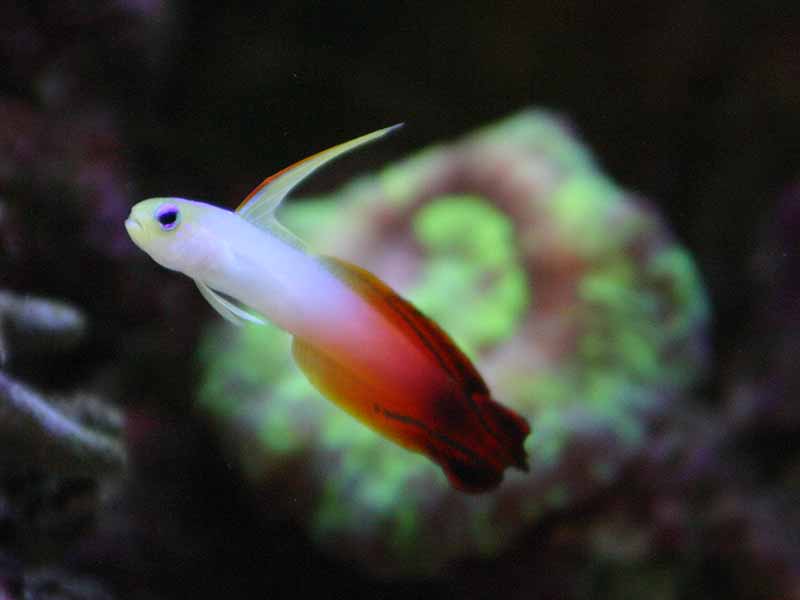
Pajama Cardinal
The Pajama Cardinal gets its name from the dots on its rear making it look like a pair of children’s polka-dotted pajamas. These wide-eyed little fish are great saltwater fish for beginners since they acclimate to a wide range of conditions making them easy to care for. They are a peaceful schooling fish, so it is best to have a school of at least three Pajama Cardinals for them to be able to thrive. The Pajama Cardinal is reef safe and peaceful towards other fish. They are a nocturnal species and may want to hide for parts of the day. Be sure to provide plenty of live rock that will help to provide a few hiding places for them to enjoy in your marine aquarium. These beautiful fish have a varied diet that you would do best to follow. They require a mix of marine flesh, feeder shrimp, pellets, and bloodworms.
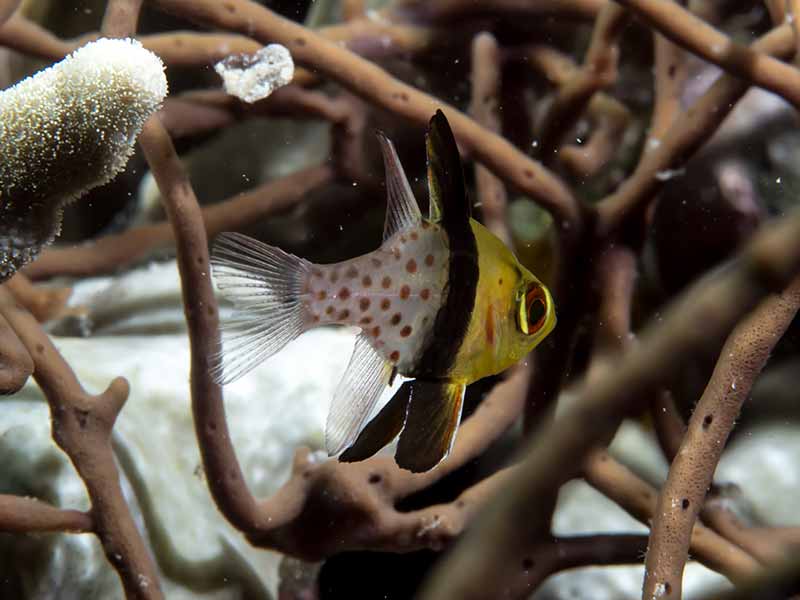
Banggai Cardinalfish
The Banggai Cardinalfish is also known as the Kaudern’s Cardinal and has a very unique and interesting color pattern. This species can reach 3 inches in length and upwards of 5 years. They prefer a lot of live rock being available in their tank with small spaces and caves. They get along with other peaceful saltwater fish. The Banggai Cardinalfish is a slow swimmer and won’t have much of an opportunity to outswim more aggressive tank mates. They need lots of swimming room and water flow to thrive in captivity.
Note of warning, this species is increasingly overfished from the wild. If you try to purchase one of these fish for your saltwater community try asking the seller where the specific fish is from. If it was caught from the wild, you should consider going somewhere else to find one that was captive-bred.
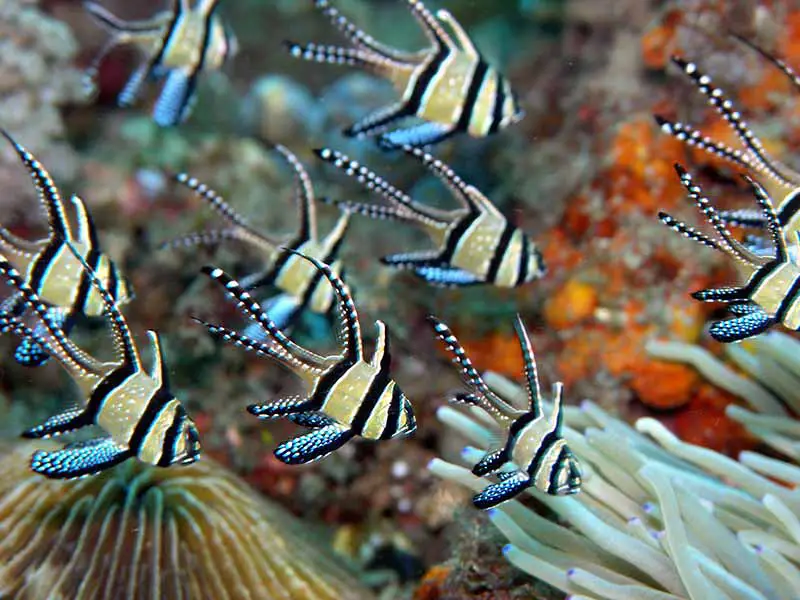
Blue Spotted Jawfish
The Blue Spotted Jawfish is a type of goby and, as should be no surprise by its name, is strongly characterized by its jaws and mouth. This saltwater fish ambushes potential prey by lying in the sand and waiting for a fish to come by, where it then snaps at it with its powerful jaws. The Blue Spotted Jawfish has brilliantly blue splotches on its sides with an orange body. It can reach 3 and a half inches in length. Like many others on this list, they are jumpers, so you need to take the proper precautions to ensure they stay safe and secure inside your reef tank.
Their reef aquarium should be well established by the time they are introduced with plenty of sand bed space. The actual sand should be fine-sized to dig around in. The Blue Spotted Jawfish is a carnivore and they will eat a range of fish and Mysid Shrimp.
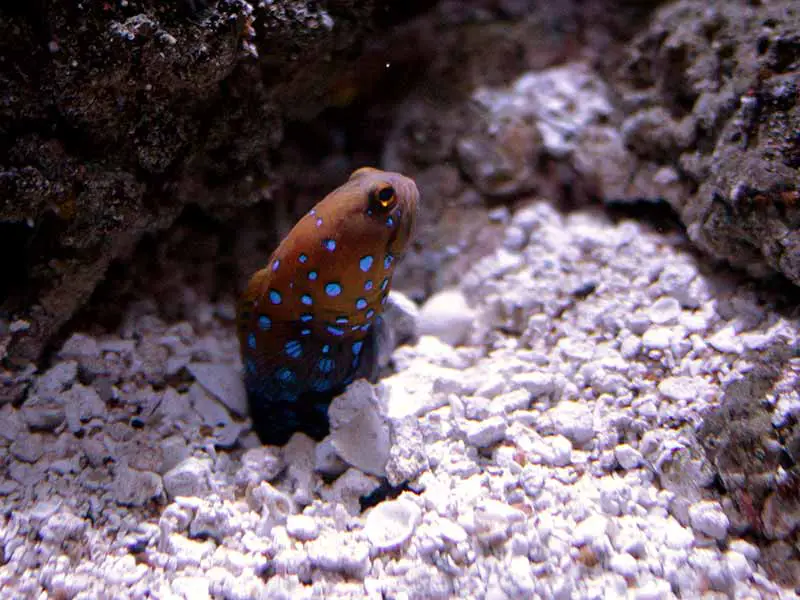
Flame Angelfish
These vibrant saltwater fish can steal the show in any reef aquarium with their bright red and orange body. There are a few things to keep in mind if you are thinking of including this fish in your reef tank. First, the fish should be kept well fed (not overfed) to prevent it from wanting to snack on corals thus potentially damaging them.
The Flame Angelfish is also considered semi-aggressive unlike some of the other fish on this list. If it is in a small tank or a tank that is overstocked it might become semi-aggressive to its fellow community members. This is easy to avoid if you plan on a 30- gallon tank with a Flame Angelfish, you can plan for fewer other additions to your reef aquarium. The Flame Angelfish diet should be made up of marine algae, Mysis Shrimp, and other high-quality meaty items. Proper Angelfish care includes providing ample space for hiding and algae nibbling. A quick warning though, it is possible your new Angelfish was shipped with a parasite or other hitchhiker, so remember to quarantine the Angelfish for a few days to see if there is anything wrong before trying to introduce the Angelsifh to our main aquarium.
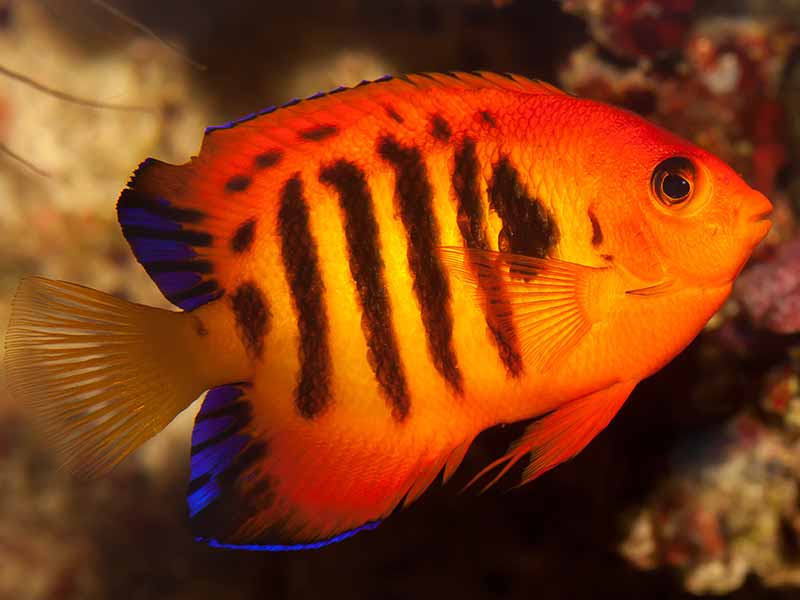
Royal Gramma
Another very popular saltwater fish, the Royal Gramma might remind you of another very popular fish, Gurgle who starred in Finding Nemo. The Royal Gramma is defined by its purple and yellow color and is a really great addition to your saltwater aquarium. These saltwater fish are hardy and are even resistant to a lot of sicknesses that could befall an aquarium fish which helps to make them easy to care for. These peaceful fish can live upwards of 5 plus years.
The Royal Gramma can reach 3 inches in length and should have a space that they can call their own as they can be quite territorial. These fish should be in a saltwater aquarium that is also full of peaceful tank mates that do not resemble the Royal Gramma’s purple color and this includes its own species. The Royal Gramma can be semi-aggressive to species that look similar to it in color, specifically its brilliant purple. Royal Grammas should be kept single in a nano reef. These fish will also not like being around fish that are bigger than them or fish that are natural predators.
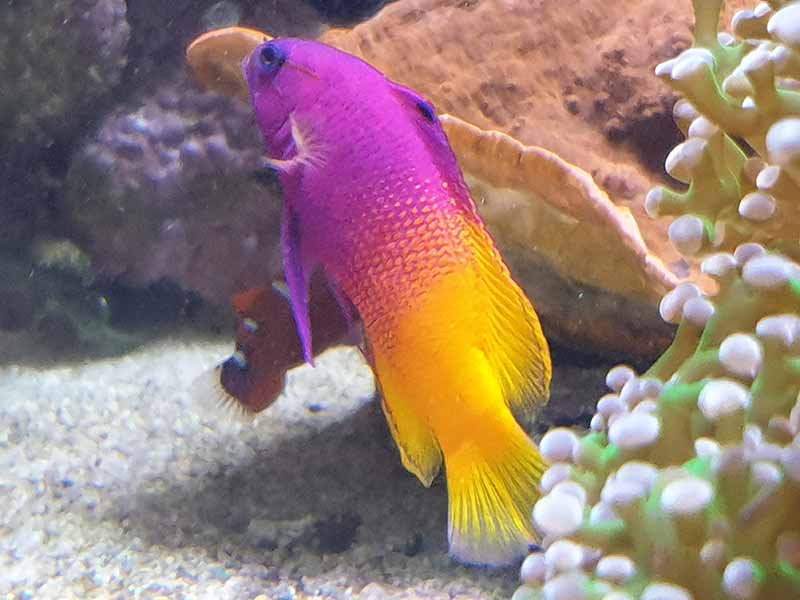
Green Chromis
Another great saltwater fish for beginners, the Green Chromis is a calm and resilient species of saltwater fish. The Green Chromis is a peaceful tank mate and can live up to 8 years in captivity. Its pale green body helps to set it apart from other species and it can grow up to 4 inches in length. This species prefers living around corals so be sure to have an environment that will best support that preference. The Green Chromis is an omnivore which means they eat a varied diet and just like their natural habitat you should do your best to match those conditions. They should have a varied diet in your tank’s community, too.
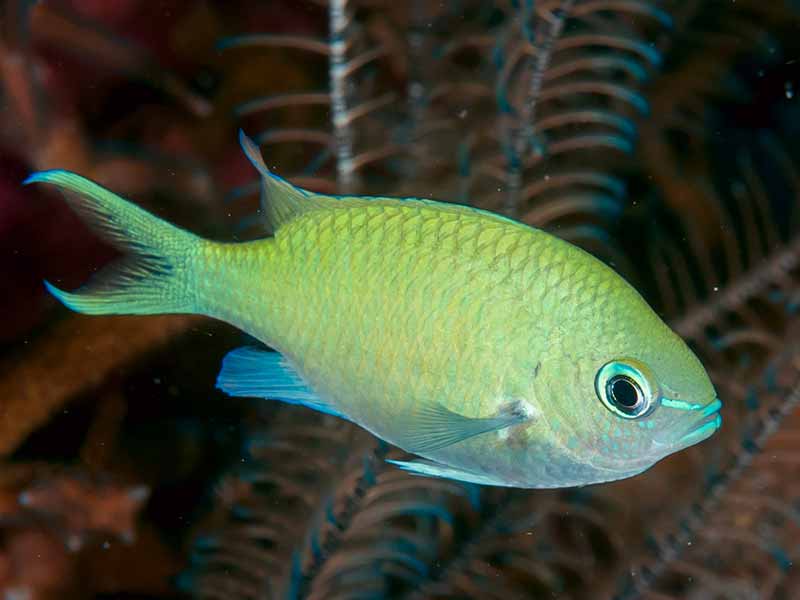
Neon Dottyback
The Neon Dotty Back has blue stripes lining its dorsal fin with a yellowish-orange body. These fish are usually captive only. They can be semi-aggressive and a little territorial. Consider making this species the last to be acclimated to your nano reef after you introduce its tank mates. The best part is that the Neon Dottyback’s are bristle worm eaters. If you have a few too many bristle worms or have a Fireworm infestation, these guys can help with that. They will eat foods that align with their carnivore preferences and should be fed about once a day if kept in a reef environment. They can reach about 3 and a half inches in length and can live upwards of 5 years.
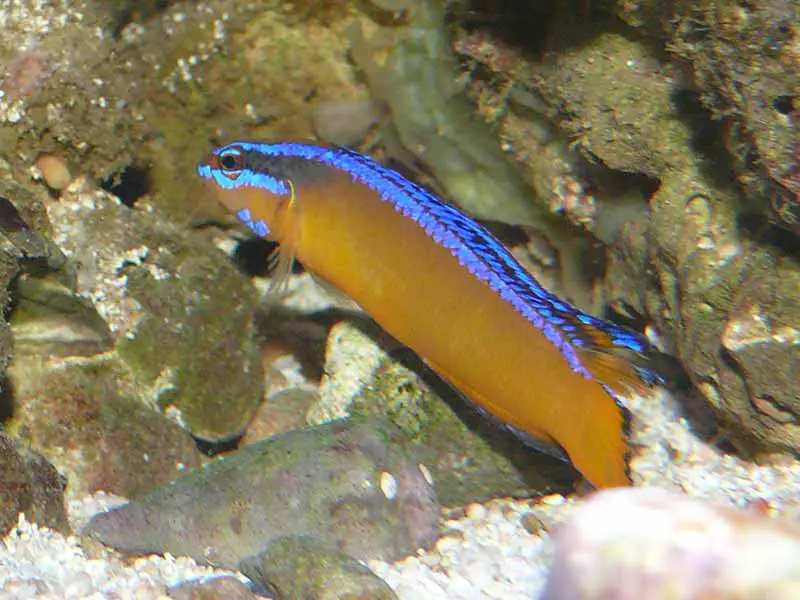
Yellow Watchman Goby
Most famously known for their symbiotic relationship with pistol shrimp, the Yellow Watchman Goby make great additions to any saltwater aquarium. They live on the sand bed so providing sand that is east to burrow in would be a necessity. These fish also require some loose coral and rocks with plenty of swimming room. They are a reef safe saltwater fish, too.
Yellow Watchman Gobies will eat a variety of meaty foods including frozen Mysis Shrimp. They are very peaceful to fish outside of their species but will create rivalries with the same-sex of their species. You will want to keep the amount of these fish to one per tank to ensure that no infighting breaks out. They can also jump out of your tank like other species on this list so ensure that you have a tight lid that will prevent that from happening.

Longnose Hawkfish
The Longnose Hawkfish is easily identified by its long nose and red striped body. They can be jumpers, so you want to ensure that you have a lid that is secure in your aquarium at all times. They can are semi-aggressive and also eat smaller species or shrimp. You will want to make sure that none of its tank mates are so small that they might be eaten by the Longnose Hawkfish. However, they are tough fish which makes them great for beginners still learning the best practices of the hobby. They need to have lots of coral and rocks to thrive but make sure that the corals you have introduced to your aquarium do not have strong stings that might injure your Longnose Hawkfish.
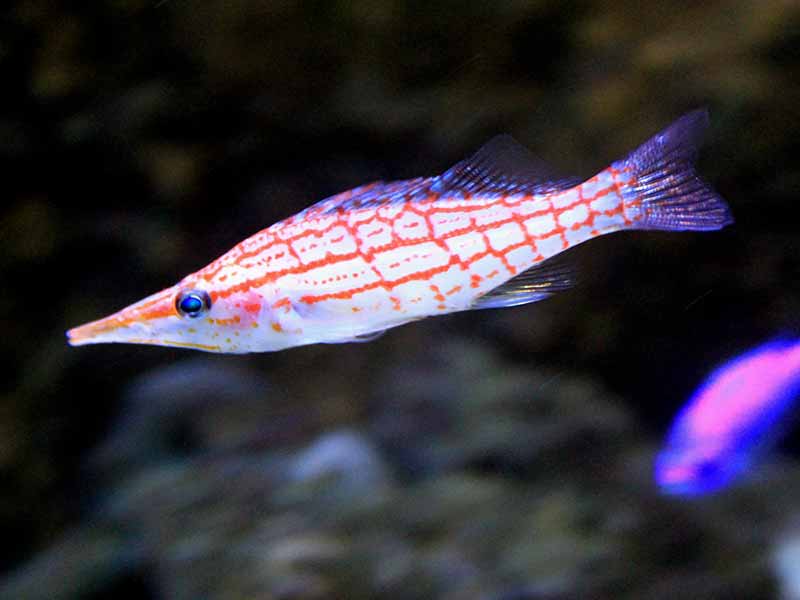
Orchid Dottyback
The Orchid Dottyback stands out for its flashy purple color and easy-care level. This saltwater aquarium fish can live up to 7 years in captivity and live off of small meaty foods. They only grow to be around 3 inches. They can be semi-aggressive but that largely depends on their overall environment. These fish become shy around other aggressive species but can become the aggressor towards other fish in a peaceful tank. Essentially, the Orchid Dottyback is the tough kid on the playground when other tough kids aren’t around.
The Orchid Dottyback is reef safe and can make a great addition to any aquarium if given the proper care. It likes to keep to the middle of the tank when it has become used to its surroundings. The Dottyback’s diet include
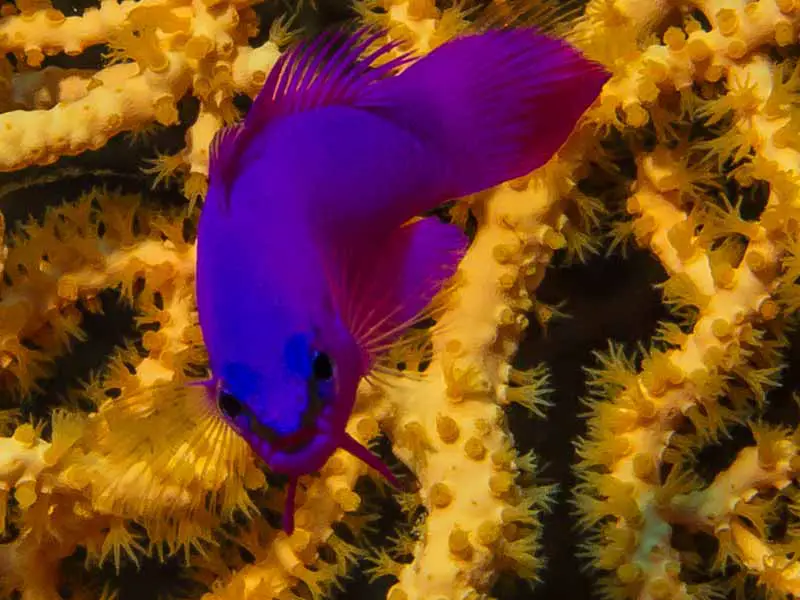
Bicolor Blenny
Blennies are my personal favorites because of their large eyes and skinny bodies. Their eyes give them a lot of character and they look a little funny, in an endearing way. As the name might suggest, the Bicolor Blenny starts with a dull bluish brown head and transitions to an orange tail. These little fish enjoy small spaces so having a 30-gallon tank with plenty of live rock that allows for crevices will make it feel safe and happy. Though they are peaceful species typically, they might be a semi-aggressive with their own species and other small fish. The Bicolor Blenny can reach to be 4 inches in length and live upwards of 4 years. Blennies make for one of the best saltwater aquarium fish and are a reef safe addition.

Striped Blenny
This species of fish is usually a peaceful bunch but can be territorial in its tank environment. And though they have sharp teeth, the Striped Blenny’s teeth are for picking at the algae on the rocks in your saltwater aquarium. The fangs are venomous, but the venom is meant as an escape mechanism if the Striped Blenny was in the mouth of a predator. The venom relaxes the victim which would allow the blenny to escape to live another day. And don’t worry, if the Striped Blenny were to bite a human it would be comparable to a bee sting more than anything else. These fish can reach 5 inches in length. They should be kept in a tank with plenty of live rock that will offer plenty of protection. These blennies, unlike the other two in this list, hunt in the water column as well as using the small spaces previously mentioned for safety. Just like most blennies, the Striped Blenny is relatively simple to care for and easy for beginners if taking the proper precautions.
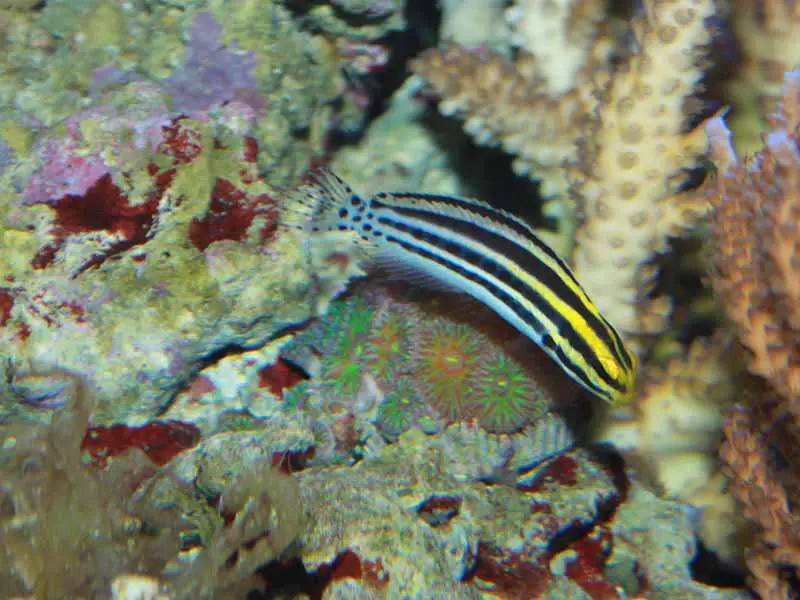
Lawnmower Blenny
The Lawnmower Blenny has the same characteristically defining eyes as the other Blennies we have discussed. However, the Lawnmower Blenny, as the name implies, loves to pick at algae and is great if you have a regular algae problem. The only concern you might have is if you don’t have a persistent algae problem, these fish might be tougher to keep fed as they can be picky eaters. If you do not happen to have enough algae to keep these fish happy, you will need to feed them microalgae.
The species does not eat larger types of algae so consider what type of algae is persistent in your tan before trying to introduce this fish into your aquarium. Macroalgae is not the favored food of these blennies. A recommended frozen food can include Reef Nutrition Formula Two. The Lawnmower Blenny can live upwards of 4 years but to accomplish this you will need to be mindful of their diet and habitat needs. Lawnmower Blenny prefers an established large tank as well as plenty of small spaces for hiding. They are a peaceful reef safe option and can get along with most other marine life.
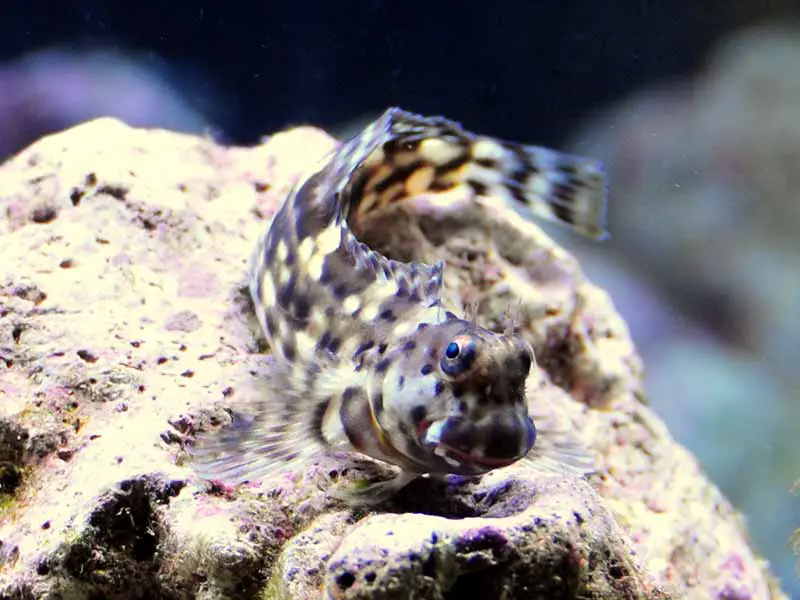
Chalk Bass
The Chalk Bass is one of the best saltwater aquarium fish for beginners. Chalk Bass can reach 3 inches in length and has a peaceful temperament. Though it is possible for larger Chalk Bass to hunt small shrimp, you can combat this by being consistent with your feeding. The Chalk bass prefers an environment that has lots of live rock for potential hiding places. It prefers to be around other peaceful fish and the Chalk Bass is another potential jumper. Keep that tank lid secure and be wary when removing it. You can feed Chalk Bass Mysis Shrimp and properly sized pellet and frozen food and they are a reef safe addition.
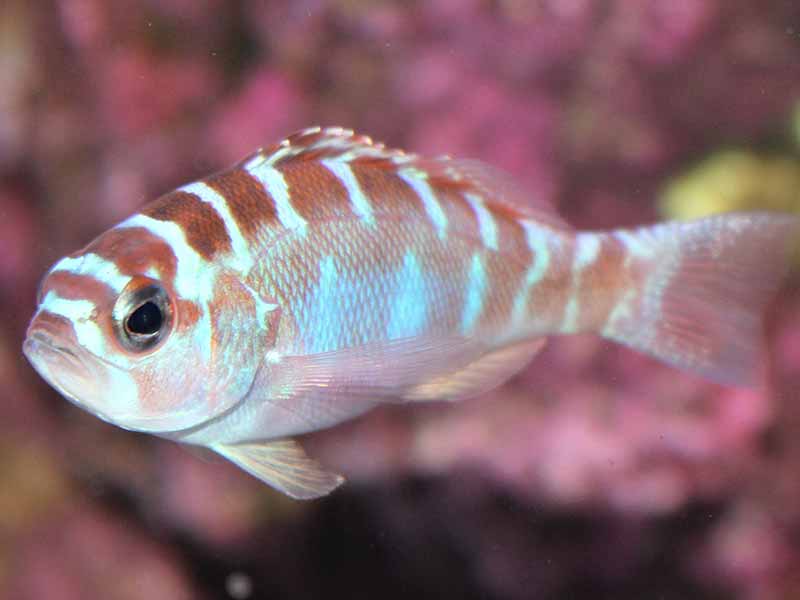
Zebra Barred Dartfish
As the name implies, the Zebra Barred Dartfish has vertical red stripes lining the sides of its body. This peaceful fish will get along with most tank mates, can reach 4 inches in length, and prefer environments with a sandy bottom and coral. You should have at least two in a tank if not a small school to make them feel at home, but these fish need to be introduced at the same time. They are small carnivores that eat frozen and fresh food as well as Mysis Shrimp. They are also very fast swimmers so try to keep them with fish that won’t be startled by their level of activity. They also appreciate spaces where they can hide. The Zebra Barred Dartfish is a reef safe addition to your aquarium. You also can not go wrong with proper pellet or flake food. Make sure that it is appropriate for a carnivore’s diet and is the correct size for the fish to properly eat.
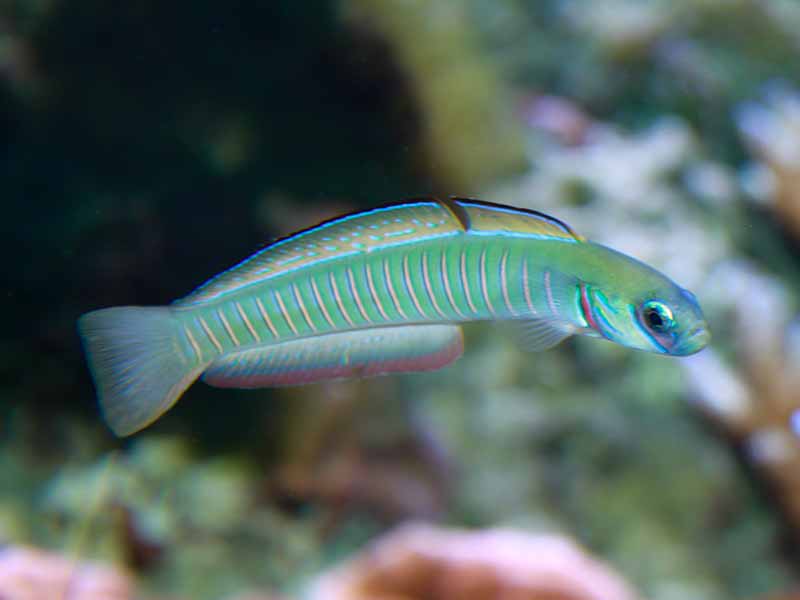
Conclusion: Tank Size Doesn't Have To Limit Your Options
These are only some of the wide array of saltwater aquarium fish that could work in your tank. They are wonderful beginner fish and you will learn a lot from them if you care for them. Any of these fish have needs that cross over with one another, so you want to look at the different preferences and behaviors of these fish. By carefully researching your fish before buying them, you avoid introducing a lot of fish that don’t conflict in needs or will fight over food or space. As you begin to learn more about the different fish and their unique personalities. This hobby is one where you are always learning new things and how to do things better than the time before. Take your time and see what works best for you.



